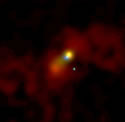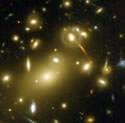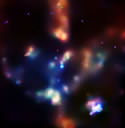
Image credit: Chandra
A new image taken by the Chandra X-Ray Observatory has provided one of the best views of two galaxies similar to our own Milky Way in the midst of a collision. All galaxies, including our own, have gone through this kind of merger in the past, so this image helps astronomers understand how the Universe came to look like it does today. The galaxies began their slow collision 10-million years ago and have already created regions of intense star formation and may eventually create a supermassive black hole.
NASA’s Chandra X-ray Observatory has provided the best X-ray image yet of two Milky Way-like galaxies in the midst of a head-on collision. Since all galaxies – including our own – may have undergone mergers, this provides insight into how the universe came to look as it does today.
Astronomers believe the mega-merger in the galaxy known as Arp 220 triggered the formation of huge numbers of new stars, sent shock waves rumbling through intergalactic space, and could possibly lead to the formation of a supermassive black hole in the center of the new conglomerate galaxy. The Chandra data also suggest that merger of these two galaxies began only 10 million years ago, a short time in astronomical terms.
“The Chandra observations show that things really get messed up when two galaxies run into each other at full speed,” said David Clements of the Imperial College, London, one of the team members involved in the study. “The event affects everything from the formation of massive black holes to the dispersal of heavy elements into the universe.”
Arp 220 is considered to be a prototype for understanding what conditions were like in the early universe, when massive galaxies and supermassive black holes were presumably formed by numerous galaxy collisions. At a relatively nearby distance of about 250 million light years, Arp 220 is the closest example of an “ultra-luminous” galaxy, one that gives off a trillion times as much radiation as our Sun.
The Chandra image shows a bright central region at the waist of a glowing, hour-glass-shaped cloud of multimillion-degree gas. Rushing out of the galaxy at hundreds of thousands of miles per hour, the super-heated as forms a “superwind,” thought to be due to explosive activity generated by the formation of hundreds of millions of new stars.
Farther out, spanning a distance of 75,000 light years, are giant lobes of hot gas that could be galactic remnants flung into intergalactic space by the early impact of the collision. Whether the lobes will continue to expand into space or fall back into Arp 220 is unknown.
The center of Arp 220 is of particular interest. Chandra observations allowed astronomers to pinpoint an X-ray source at the exact location of the nucleus of one of the pre-merger galaxies. Another fainter X-ray source nearby may coincide with the nucleus of the other galaxy remnant. The X-ray power output of these point-like sources is greater than expected for stellar black holes accreting from companion stars. The authors suggest that these sources could be due to supermassive black holes at the centers of the merging galaxies.
These two remnant sources are relatively weak, and provide strong evidence to support the theory that the extraordinary luminosity of Arp 220 – about a hundred times that of our Milky Way galaxy – is due to the rapid rate of star formation and not to an active, supermassive black hole in the center.
However, in a few hundred million years, this balance of power may change. The two massive black holes could merge to produce a central supermassive black hole. This new arrangement could cause much more gas to fall into the central black hole, creating a power source equal to or greater than that due to star formation.
“The unusual concentration of X-ray sources in the very center of Arp 220 suggests that we could be observing the early stages of the creation of a supermassive black hole and the eventual rise to power of an active galactic nucleus,” said Jonathan McDowell of the Harvard-Smithsonian Center for Astrophysics, Cambridge, MA, another member of the team studying Arp 220.
Clements and McDowell were joined on this research by an international group of researchers from the United States, United Kingdom and Spain. Chandra observed Arp 220 on June 24, 2000, for approximately 56,000 seconds using the Advanced CCD Imaging Spectrometer (ACIS) instrument.
ACIS was developed for NASA by Pennsylvania State University, University Park, PA, and the Massachusetts Institute of Technology, Cambridge, MA. NASA’s Marshall Space Flight Center in Huntsville, Ala., manages the Chandra program, and TRW, Inc., Redondo Beach, Calif., is the prime contractor. The Smithsonian’s Chandra X-ray Center controls science and flight operations from Cambridge, Mass.





